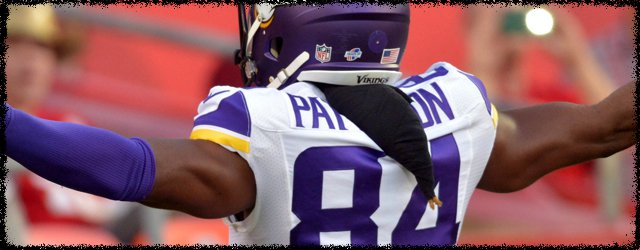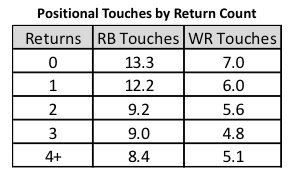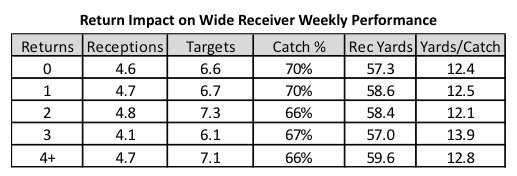Does Returning Reduce Your Fantasy Return?

When evaluating players before the start of a fantasy season, the last thing I think about is their contribution to the return game. The recent news that C.J. Spiller will be a primary kick returner for the Buffalo Bills was predictably met with yawns and indifference. However, should that really be the case?
A returner, whether it is for punts or kickoffs, is subjected to additional punishment with little fantasy contribution outside of a return touchdown (unless you are in a league that rewards return yardage). So does that extra responsibility cause a player to become less effective in their offensive role and do they have a diminished role in the offense based on their contribution to the return game? These are the questions that will be examined with a recommendation on how to treat these players in the future.
Methodology
When looking to examine the impact of being a returner, there are several thresholds that had to be put in place. Knowing teams employ multiple returners, it is important to focus on players who are large contributors on special teams. As such, a player needed to be a top 50 returner in a given year; defined by the number of returns, yardage, and touchdowns. Similarly, a player had to finish as a top 50 fantasy scorer at their position that same year.
When looking at the 2007-2013 seasons, there were a total of 29 players who produced 43 instances falling under the aforementioned guidelines. Of the 29 players, 17 were wide receivers and the remaining 12 were running backs.
Those 43 seasons are broken down by game to examine the changes in performance regarding offensive and return statistics. What results below is the aggregation of that information to help answer the posed questions.
Analysis
[am4show have=’g1;’ guest_error=’sub_message’ user_error=’sub_message’ ]
Looking at the highest level, let’s examine if we see a variance in performance when a player fields a return. Below takes a look at games where a player does not have a single return compared to those where he receives at least one.

Players see about a 50% chance they will outperform their seasonal average fantasy points when they also have a return. Compare that to the 60% likelihood a player outperforms their average when they do not have a return in the game – this suggests that the rigors of the return game can impact the offensive part of the game.
Going a step further, how does the number of returns impact the likelihood of an above average game? Looking below, zero returns remains the highest probability of success with one return showing the next highest percentage.

On the flip side, we see sub 50% success rates (as defined by an above average game) for any multi-return tiers. This again enforces the idea that increased work in the return game impacts offensive output.
Now, does that decrease in offensive output result from decreases in efficiency (e.g. yards per carry lower) or is usage to blame for the lower fantasy performance? The short answer, which is shown below, is a change in usage by return level.

The difference in touches for both positions is around 30% when comparing the zero return figures against the instances where a player exceeds three returns. I think this speaks to the fatigue we see with the added touches on special teams, but there may be a component where coaches are scaling back a player’s returns in certain weeks where they may be needed on offense due to injuries or a change in game planning.
Digging deeper into the individual positions, let’s start with the wide receivers. When looking at most of the baseline statistics, there are not many significant differences in receiving based on return levels.

A few interesting pieces to note are the slight declines in catch percentage, indicating a lower level of efficiency for those games. However, that seems to be offset by a higher yard per catch in games with higher numbers of returns. It is difficult to explain that difference other than many of the high return games belong to long distance threats like DeSean Jackson and Steve Breaston.
Switching gears to the running back position, there is a clearer distinction on the impact of the return game on offensive usage. Looking below, the rushing attempts take a continuous decline as a running back is used more frequently as a returner.

This provides a view into the coaching staff’s reaction to heavier special teams involvement. What is good to see is that the effectiveness of a running back (in this case, yards per attempt) remains pretty constant with the exception of a slight dip at the highest return usage rate.
Conclusion
Overall, there is some impact to a running back or wide receiver in games where they see a good amount of return work. Here are a few key points that can be useful when thinking about fantasy players that are also used as returners.
- The probability of an above average game is greater when a player has no returns (60%) than when he has to participate in the return game (48%)
- Multiple returns also decreases the probability of an above average game when compared to zero or one return games
- Offensive usage decreases as special team usage increases for both running backs and wide receivers
- Wide receivers see a similar target rate, but slightly less efficiency in catching the ball when they are more involved in the return game
- Running backs receive less carries as their number of returns increase
These points should not deter you from owning players like Cordarrelle Patterson or the aforementioned Spiller. Instead, be mindful that as long as those players are contributing in the return game, their coaches will be monitoring their offensive production, limiting their upside in certain games. Hopefully, you will see them taken off special teams as coaches scheme to expand their roles in the offense. It may even present an opportunity to trade for them while their value is slightly depressed due to their involvement in the return game.
In week one, Spiller saw only one return opportunity and had 18 offensive touches, although he averaged less than four yards per touch.
As always, you can find me on Twitter @Rotohack or in the comments section below!
[/am4show]
- Bowl Game Previews: CFB Playoff Semifinals - December 28, 2018
- The Narrative Fallacy and How it Compels Us - May 13, 2017
- 2017 NFL Draft – College Wide Receiver AIR - April 27, 2017

































































